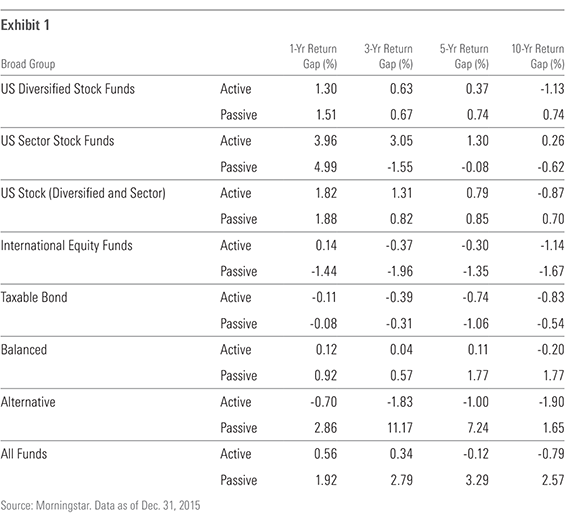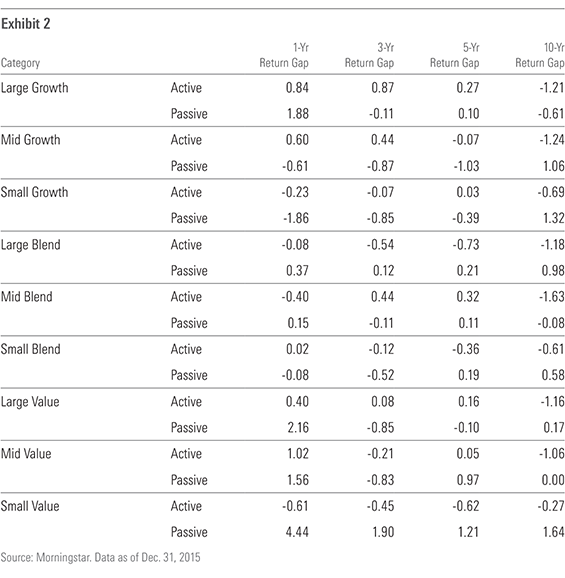Mind the Gap: Active Versus Passive Edition
The biggest costs investors tend to incur don’t show up on a fact sheet but are a product of their own bad behavior.
A version of this article was published in the April 2016 issue of Morningstar ETFInvestor. Download a complimentary copy of ETFInvestor by visiting the website.
When it comes to investing, we are so often our own worst enemy. Countless studies have shown that we tend to chase performance--buying high, selling low, and failing to learn from our mistakes every time. This applies to individual stocks [1], funds, gold, baseball cards, classic cars, you name it.
We pay a steep price for our actions, one that can be many multiples of a commission or an annual fee. In the realm of funds, we can roughly quantify the cost of this bad behavior. For years, my colleague and Morningstar FundInvestor editor Russ Kinnel has documented this phenomenon and sized the toll it takes on investors' returns in his annual "Mind the Gap" study.
Sizing the Gap We can approximate the self-imposed penalty investors incur as a result of their own actions by looking at the difference between the returns that funds generate (time-weighted returns) and the returns that investors experience (cash-flow-weighted returns). Time-weighted returns are commonplace; they are a simple measure of the compound rate of growth in an investment. These are the returns featured in fund company fact sheets and Morningstar's Growth of 10k charts. Cash-flow-weighted returns are less familiar. They account for money flowing into and out of individual funds. Morningstar introduced Morningstar Investor Returns in 2006 to better measure investors' actual (average) experience with funds.
By subtracting funds’ time-weighted returns from their Morningstar Investor Returns we can get a sense of how well investors tend to use a particular fund, on average, or a specific group of funds. Negative values indicate that investors are leaving money on the table, while positive ones are generally indicative of good behavior. Over the years, Russ has found that the behavior gap across most broad Morningstar Categories (U.S. equity, sector equity, taxable bond, and so on) has been generally negative--though its magnitude has varied over time. Also, Russ has found that less risky and less costly funds tend to have narrower return gaps over time.
How Do Investors in Passive Funds Tend to Behave? Here I want to turn over a different stone. I want to examine how, on average, investors in passively managed funds behave relative to investors in actively managed funds. To do so, I asked my colleague Annette Larson (thank you, Annette!) to run the numbers, calculating average time-weighted returns and Morningstar Investor Returns for all active and passive mutual funds in Morningstar's U.S. funds database. [2] The summary results are in the accompanying tables.
Survey Says ... On average, passive funds had a positive return gap during the trailing one-, three-, five-, and 10-year periods ended Dec. 31, 2015. Not only was this gap positive, but its magnitude was significant. Passive funds' 10-year return gap was 2.57%. The average return gap across all active funds during the decade ended 2015 was negative 0.79%. At first blush, it appears as though investors in passive funds are heading to choir practice while active fund investors are smoking in the boys' room (hat tip to Mötley Crüe).

The most significant (in terms of where investors’ assets are) divergence in investor behavior between the active and passive cohorts was in diversified U.S. stock funds. Both active and passive diversified U.S. stock funds had positive return gaps during the trailing one-, three-, and five-year periods, though passive funds’ gaps were modestly higher. During the trailing 10-year period, passive funds’ return gap was 1.87%, while active funds’ was negative 0.88%. Looking at the breakdown of return gaps across each of the nine categories that form the Morningstar Style Box, this relationship is fairly consistent for the trailing 10-year period. This likely reflects the exodus from actively managed U.S. stock funds that has continued and indeed accelerated over the course of the stock market’s now seven-year rally.
Also worth noting is the relatively poor behavior of investors in passively managed international-equity funds. In this grouping, investors in passive funds have consistently fallen victim to their own poor timing decisions. Investors in actively managed international-stock funds haven’t exactly been terrific market-timers, either, but they’ve fared much better than index investors.
Last, investors in both active and passive taxable-bond funds did themselves more harm than good when timing their purchases and redemptions. Return gaps among both cohorts were consistently negative during each period, though passive funds’ return gaps were marginally less so during the trailing one-, three-, and 10-year periods.

What Might Explain These Differences? There are countless factors that drive investment flows: market conditions, valuations, demographic trends, and seasonality, just to name a few. In theory, they should all have the same effect on investors' behavior, on average, regardless of whether they're investing in actively managed funds or passive ones. What explains the differences in behavior between the two? I'd argue there are two main factors at play here. The first has to do with investors' expectations; the second has to do with investment channels.
Investors in passively managed funds generally have a standard set of expectations. They will get--to paraphrase Vanguard founder John Bogle--the market return less a fee. Of course, as we know, earning the market return minus a tiny fee is generally a winning proposition over a long time horizon. Index investors also know not to expect the unexpected. Manager changes, prolonged bouts of underperformance, or hefty capital gains distributions are of no concern to index fund investors. In other words, for index investors there are no alarms and no surprises (hat tip to Radiohead). So with their expectations set and little chance for surprise along the way, index fund investors are generally content to sit tight and earn the market’s return. This is evident in the return gap data.
I believe that there are also investment-channel-specific considerations that can partly explain the differences in return gaps between active and passive funds. In particular, I believe the fact that index funds are prevalent in many employers’ 401(k) menus and represent a growing share of target-date funds’ assets (of course, target-date funds are increasingly the default investment options in many 401(k) plans) has played a significant role in the growth of index funds in general and the population of well-behaved, disciplined index fund investors in particular. In the defined-contribution channel, index funds, whether they are standing on their own or part of a target-date series, receive regular, systematic contributions, and plan participants face stiff penalties on withdrawals. Indeed, in Russ’ latest edition of “Mind the Gap,” he found that target-date funds had positive gaps across the board.
Key Take-Aways 1) The biggest costs investors tend to incur don't show up on a fact sheet but are a product of their own bad behavior.
2) Investors in passive funds have tended to pay smaller bills for their conduct over time.
3) Index fund investors' reasonable expectations, or as Bogle has referred to it, index funds' "relative predictability," go some way toward explaining their exemplary behavior.
4) Channel-specific considerations have also played a part. 401(k) plans are a pipeline for legions of disciplined investors.
[1] Barber, B. & Odean, T. 2000. "Trading Is Hazardous to Your Wealth: The Common Stock Investment Performance of Individual Investors." Journal of Finance, Vol. 55, No. 2, P. 773.
[2] We do not calculate Morningstar Investor Returns for exchange-traded funds. ETFs are used by many different investor types in a variety of ways. As such, it is difficult to understand ETF investors’ intent and draw conclusions about their behavior. For example, inflows into a particular ETF may be the result of create-to-lend activity, where demand for an ETF’s shares is being driven by opportunistic short-sellers and not long-term strategic buyers. Having this type of noise in the data would make it difficult to use ETF investor returns in any sort of gap analysis.

Disclosure: Morningstar, Inc.'s Investment Management division licenses indexes to financial institutions as the tracking indexes for investable products, such as exchange-traded funds, sponsored by the financial institution. The license fee for such use is paid by the sponsoring financial institution based mainly on the total assets of the investable product. Please click here for a list of investable products that track or have tracked a Morningstar index. Neither Morningstar, Inc. nor its investment management division markets, sells, or makes any representations regarding the advisability of investing in any investable product that tracks a Morningstar index.

/s3.amazonaws.com/arc-authors/morningstar/a90ba90e-1da2-48a4-98bf-a476620dbff0.jpg)
/cloudfront-us-east-1.images.arcpublishing.com/morningstar/NPR5K52H6ZFOBAXCTPCEOIQTM4.png)
/cloudfront-us-east-1.images.arcpublishing.com/morningstar/OMVK3XQEVFDRHGPHSQPIBDENQE.jpg)
/d10o6nnig0wrdw.cloudfront.net/09-24-2024/t_c34615412a994d3494385dd68d74e4aa_name_file_960x540_1600_v4_.jpg)
:quality(80)/s3.amazonaws.com/arc-authors/morningstar/a90ba90e-1da2-48a4-98bf-a476620dbff0.jpg)